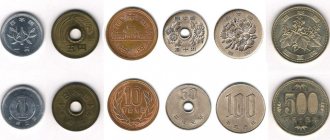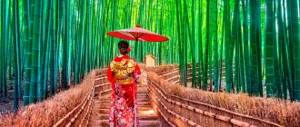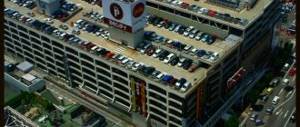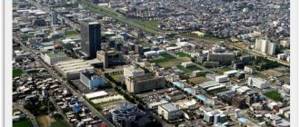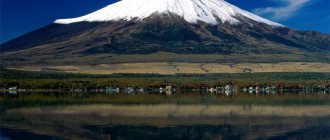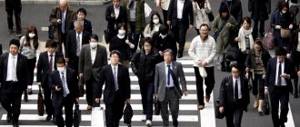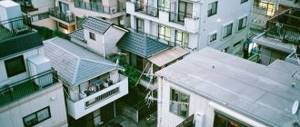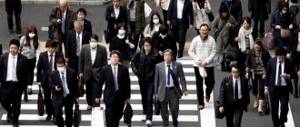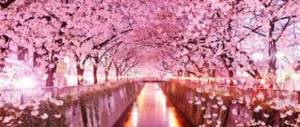Japan, without exaggeration, is the most technologically advanced country in the world in many industries. And they have corresponding high-speed trains. They are called Shinkansen (新幹線
),
which can be translated as: “New”←(新) “highway”←(幹線). This is the so-called “bullet train”, which covers a distance of hundreds of kilometers in a matter of hours. High-speed trains in Japan are considered one of the fastest in the world and can reach speeds of up to 320 km/h (we'll go into more detail on this a little later), which is an outstanding figure as of 2013. Due to their very elongated shapes for better streamlining, in appearance the trains are more reminiscent of “futuristic cruisers” than 21st century transport. 
Shinkansen N700
Shinkansen trains were launched for the opening of the Olympic Games in Tokyo in 1964: the first trains ran from Tokyo to Osaka on the Tokaido Line at a speed of just over 200 km/h, which was simply crazy speed at that time.
First Shinkansen
The Shinkansen route on the Tokaido Line is still the most congested line in the world . Another interesting fact: since the opening (i.e. since 1964), not a single accident has occurred, i.e. in fact, it is a very safe form of transport!
A little information: The line was named “Tokaido” because in ancient times the Tokaido tract connected two capitals - Edo (now Tokyo) and Kyoto.
When I was traveling on the Tokaido route from Tokyo to Osaka and back, I noticed how often these trains run: if in Germany, for example, ICE class high-speed trains run every 2 hours (if memory serves), then trains in Tokyo run every 20-30 minutes. In Russia, even local trains don’t run like that!
Shinkansen uses European gauge (1435 mm). All Shinkansen are electrified. The cost of a ticket from Tokyo to Osaka on the Shinkansen is approximately 13,000 - 14,000 yen ($126-136) one way (children are about 2 times cheaper), which is quite expensive, but still much more comfortable than an airplane, because... The Shinkasen rides very smoothly and with sufficiently large turns of the body it is simply not noticeable, and the location is more convenient: the airport is located on the outskirts, and the station is in the center. Usually, airlines rely only on the fact that they try to make an air ticket cheaper than a train ticket.
By the way, having bought a Shinkansen ticket, for example, to Osaka, you will have the opportunity to travel around the center for free (one time), and if you need to get to the final station, it will still cost less, because the cost of the “center” (23 districts of Osaka) is already included in the Shinkansen ticket, which is very nice. The situation is the same with Tokyo: travel through all 23 special districts of Tokyo (that is, the center) will cost you free, but if you travel even further you will need to pay extra.
High-speed trains in Japan: from 240 km/h to 320 km/h.
As someone said, Japan is a country out of this world. Indeed, Japan is considered one of the most high-tech countries. Some even claim that Japan has long been in the 22nd century. This is, of course, not true. Nevertheless, Japan has long surpassed many developed countries in terms of technology. Especially when it comes to high-speed trains.
Japan's railway fleet is one of the most modern and high-speed in the world. Only in this country can you not only see, but also ride on a large number of incredibly fast passenger trains, famous for their high speeds and unsurpassed punctuality.
Features of high-speed trains
A high-speed train is a real godsend for those people who need to quickly, safely and comfortably get from point A to point B. A special feature of this train is magnetic suspension. Due to it, he cannot move on standard rails. It requires a special fabric that can withstand increased loads.
It is interesting to note that the first high-speed train was created by the French company Alstom in 1971. However, traffic on high-speed lines was launched only 10 years later.
Today there are a large number of high-speed trains around the world. Only 10 of them are included in the TOP fast trains:
- Maglev Train (Japan);
- TGV POS V150 (France);
- ML-500R (Japan);
- TR09 (Germany);
- Harmony-380A (China);
- Shinkansen (Japan);
- Aerotrain I80HV (France);
- THSR 700T (Taiwan);
- KTX2 (South Korea);
- Sapsan (Russia).
Each of the compositions is unique in its own way, and therefore deserves separate consideration.
Akita Line, Train E6, Japan East Railway
E6 series trains such as Akita reach an average speed of 128 km/h. Although the train in some sections travels at a speed of 320 km per hour.
Capacity: 336 people
Maximum speed: 320 km/h
The E6 train runs on a mini-high-speed line, part of which runs along the Tohoku railway line, which allows the train to accelerate to 320 km per hour.
However, as soon as the railway branches west towards Akita, the train's maximum speed drops from 320 to 128 km per hour.
see also
Chinese train with a top speed of 600 km/h will become a reality
How much is it worth in yen?
It’s a fact: you have to pay for the speed and comfort of moving around Japan. But if you wish, you can move slowly (and for free) along ordinary streets on the first level. The only problem is that along the way there will be traffic lights, intersections, and one-way traffic. That means it will take a long time to travel. And at the upper levels there are toll roads, very fast. Any navigator (it’s impossible to imagine a car in Tokyo without such a device) will offer several routes, depending on traffic congestion and the cost of travel.
Money for travel is debited from the owner’s account automatically, in a contactless way: the car flies through payment points without stopping. The amount depends on the distance: if you drive a lot, you pay a lot. Recently, a fixed minimum fee was introduced for travel on small sections of toll highways within the city - 500 yen (about 200 rubles); at night discounts up to 50%.
City center, workday morning... Nothing to add.
City center, workday morning... Nothing to add.
What is absolutely amazing is that cars are not parked along the streets. This is prohibited throughout the city and is punishable instantly! A fine of 25 thousand yen (approximately 8200 rubles) plus towing of the car. What about cars, they even tow away a bicycle that has been left behind incorrectly! Of course, there are parking lots in the city, but they are not cheap - from 600 yen (200 rubles) per hour. And parking time is often limited. A monthly parking pass in the city center costs on average about 15 thousand yen (5,000 rubles).
However, everyone has probably heard that a new full-size car will not be registered in Tokyo if the future car owner does not have a parking space. This should be a designated parking space, and not the side of the road or a driveway in the yard. A policeman comes specially, inspects the indicated place, checks all the documents and only then gives permission for the car. A parking space can be bought or rented - in a residential area for about 30 thousand yen (about 10 thousand rubles) per month. Not cheap? Yes, but the Japanese have quite a lot of income! The average salary in the country (after paying all taxes) is 270 thousand yen (almost 90 thousand rubles), and in Tokyo - under 300 thousand yen.
Most Japanese do not drive a private car to work and use it mainly on weekends. But even then, a real Japanese will first calculate how much a trip by personal car will cost and compare it with the cost of a train ticket. By the way, young Japanese are increasingly refusing to own a car: it is painfully expensive to maintain. And it’s not easy to get rights. Tuition at a driving school will cost almost 300 thousand yen (under 100 thousand rubles!), and passing the exam to a strict commission is not easy. It is much easier to travel by metro or bus.
At the first level, movement around the city is free. However, it will not be fast: there will be numerous traffic lights and pedestrian crossings along the way.
At the first level, movement around the city is free. However, it will not be fast: there will be numerous traffic lights and pedestrian crossings along the way.
Joetsu Line - E7 and E4 train series, East Japan Railway
The E4 series (pictured) is unique in the Japanese railway fleet because it is a double-decker high-speed train
Capacity: 934 people (train E7), 1,634 people (train E4).
Maximum speed: 260 km/h (E7 train) and 241 km/h (E4 train)
The E7 and E4 series bullet trains are not obsolete, but are nevertheless the slowest in the railway fleet, with a maximum speed of 260 km/h and 241 km/h respectively.
However, the E4 series is unique in Japanese railway rolling stock because it is a double-deck train.
The train consists of eight carriages with a capacity of 1,634 seated passengers.
Tokaido/Sanyo Line, N700A series trains, Central and Western Japan Railway
Capacity: 1,323 people
Maximum speed: 300 km/h (Sanyo Line) and 285 km/h (Tokaido Line).
The trains on these two lines are some of the most photographed in Japan because they pass Mount Fuji as they rush west.
To view the 3,776-meter-tall volcano, which is about 100 kilometers from Tokyo, sit on the right side of the train when traveling west. When traveling back, accordingly, sit on the left side of the train. The volcano will appear in your field of vision 44 minutes after leaving Tokyo.
The letter "A" in the name of the train series means "advanced".
The N700 and N700A trains have a one-degree tilt capability, which allows them to reach higher speeds when passing curved sections of the road. But the N700A series train can accelerate faster.
However, many of the older trains have recently been upgraded with technology found on the more modern A-class trains.
Olympic history
The traffic problem in Tokyo became a serious concern back in the early 1960s, during the preparation for the 1964 Olympics. At that time, many city streets remained unpaved, and he was suffocated by kilometers-long traffic jams. Scientists, by the way, even in those days realized the dependence of the development of the country’s economy on the state of traffic. As a result, a program for the construction of expressways was adopted, both in the capital and throughout the country. The first such highway, 71 km long, appeared in 1963. The Tokyo government has adopted the concept of solving transport problems within the existing city through the construction of multi-level highways and interchanges. To do this, the city bought one-story houses, old block high-rise buildings and inefficient enterprises from their owners in order to build multi-tiered overpasses in their place.
From here they control the traffic of Tokyo's 15 million population. The left display shows the situation on highways, and the central display shows all other roads.
From here they control the traffic of Tokyo's 15 million population. The left display shows the situation on highways, and the central display shows all other roads.
And in twenty years, the Japanese managed to do the impossible - turn a city paralyzed by traffic jams into one of the most prosperous in terms of traffic management. Expressways penetrate the capital in different directions and at different levels, and you can get from one remote area to any other, bypassing the center, without traffic jams.
There have been no free spaces in Tokyo for a long time, so in some places the tracks are located on five levels, the top of which is at the height of the tenth floor! What is very important, highways do not replace or cancel ordinary streets where normal city life takes place. And highways are for high-speed travel over long distances, and in order to quickly get to the opposite end of the metropolis, you can choose one of eight free or four paid high-speed rings.
Several old quarters have been preserved in the city center, which attract thousands of tourists. There's just nowhere to park.
Several old quarters have been preserved in the city center, which attract thousands of tourists. There's just nowhere to park.
Sanyo/Kyushu Line, train series N700-7000 (Western Japan Railway)/N700-8000
The photo shows train N700-7000 of the Sanyo line. The train is owned by Western Japan Railway. The train goes to Kyushu Island
Capacity: 546 people
Maximum speed: 300 km/h (Sanyo Line), 260 km/h (Kyushu Line)
Train N700-7000 runs all the way to Kyushu Island on the Sanyo and Kyushu lines.
The Sanyo Line, which terminates at Hakata Station in Fukuoka, was the second line to be built and opened in 1975.
The Kyushu Line extension began in 2004 and was completed in March 2011.
The N700-8000 series bullet train runs to Kagoshima-Chuo, the southern terminal of the Kyushu Line, and is currently the southernmost stop on Japan's railway network. The N700-8000 train has the same exterior livery as the N700-7000. The line is currently being extended to Nagasaki, with service expected to begin in 2022.
see also
World's first hydrogen train revealed
How to book a Shinkansen ticket.
Ticket booking is possible as early as 30 days before the planned date of travel.
. You can make a reservation in several ways:
| At the ticket counter (Ticket counter) You can book your ticket in person at the ticket offices of all major JR stations throughout Japan. Tickets for any Shinkansen can be purchased from this JR ticket office in Japan. |
| Vending machine Various vending machine options allow travelers to book a ticket for the Shinkansen (these machines usually have bilingual menus in Japanese and English). However, Japan Rail Pass holders cannot use vending machines to book tickets. |
| Online Booking JR East has an English website that allows Japan Rail Pass and JR East Pass holders to book tickets on the Tohoku, Yamagata, Akita, Joetsu and Hokuriku . A similar online order cannot be made for other lines. Each JR company also has a Japanese version of their online booking websites, however, these sites require Japanese language skills and Japanese citizenship. |
More information in English can be found by clicking here
Kyushu Line, 800 train series
The 800 series trains spend a lot of time in tunnels on the Kyushu Line. Inside, the train has a homey interior, with wooden seats and floors.
Capacity: 384 people
Maximum speed: 260 km/h
The 800 series of trains began operating in 2004.
Its maximum operating speed is 260 km per hour, but the train is designed to reach a speed of 285 km per hour.
Large sections of the Kyushu Line are in tunnels, so the designers of the 800 series made the interior of the train as pleasant as possible, with wooden seats and floors for a more homely atmosphere.
Bus-san
Most workers in Tokyo commute to their skyscrapers by public transport. They have an extensive metro network at their disposal; Several lines belong to the state, but there are also private ones. There are many routes of city trains; they run on the ground or overpasses. A separate, rather large network has a monorail, which also began to be developed back in the 60s of the last century, before the Olympics. By the way, everywhere in the morning and evening it can be quite crowded; During peak hours, special metro employees even pack passengers into carriages. Therefore, on some lines you will find first class carriages and special carriages for women.
And how can we not mention the famous Tokyo taxi! A yellow and black Toyota Crown or Nissan Cedric will drive anywhere at any time of the day. But the passengers are increasingly foreigners: the locals think it’s expensive. This is probably true, but I still drove through the city at night in a taxi. Beauty! And the price... You know, no more than in Moscow.
The city is expanding due to the bulk islands. The modern Odaiba district is one of these, connected to other parts of the metropolis by several bridges and tunnels. Five minutes and you are in the very center of the capital.
The city is expanding due to the bulk islands. The modern Odaiba district is one of these, connected to other parts of the metropolis by several bridges and tunnels. Five minutes and you are in the very center of the capital.
In general, Tokyo through the eyes of Rousseau tourist is a city where the traffic problem has been solved. True, at what cost! It’s expensive to have a personal car in this city, but if you dare, you’ll go. Exactly. And no problem. Moreover, they were solved primarily not at the cost of restrictions, but through large-scale road construction. Plus high-tech intelligent motion control systems, but that comes later. All the largest megacities in Asia, primarily Chinese, are now trying to solve traffic problems using similar methods.
Russia is taking a different path - European cities are taken as a model. But they started solving these problems about fifty years ago, and we are tinkering with their old patterns and hoping that they will work in the 21st century. Alas. Meanwhile, the capital's mayor's office decided to reduce the highway construction budget by one and a half times, focusing on the reconstruction of existing ones. Plus paid parking.
Japanese policeman! Traffic in Japan
Yamagata Shinkansen Line, E3-1000 and E3-2000 series trains, Japan Western Railway
The E3 train series is a slightly narrower high-speed train and serves the Yamagata Line at speeds of up to 275 kilometers per hour.
Capacity: 394 people
Maximum speed: 275 km/h
Another train that travels at a speed of 275 km/h for part of the journey, but once the tracks branch, the train to the Shinjo terminus travels at a maximum speed of 128 km/h.

